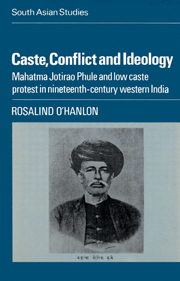 Caste, Conflict and Ideology
Caste, Conflict and Ideology Book contents
- Frontmatter
- Contents
- Acknowledgements
- Notes on translations and area under study, with map
- Part 1 Introduction
- Part 2 Religion and society under early British rule
- Part 3 Jotirao Phule and his circle: the emergence of a distinctive radical voice
- Part 4 The creation of a lower caste identity in history and popular culture, 1869–73
- 7 Ritual status and political conflict in later nineteenth-century Maharashtra
- 8 The Aryan invasions and the origins of caste society
- 9 Warriors and cultivators: the reinterpretation of popular culture
- 10 Maratha history as polemic: low caste ideology and political debate in late nineteenth-century Maharashtra
- Part 5 The lower caste community in contemporary society
- Part 6 Ideology and the non-Brahman movement in the 1880s
- Bibliographic note
- Bibliography
- Glossary
- Index
10 - Maratha history as polemic: low caste ideology and political debate in late nineteenth-century Maharashtra
from Part 4 - The creation of a lower caste identity in history and popular culture, 1869–73
Published online by Cambridge University Press: 14 October 2009
- Frontmatter
- Contents
- Acknowledgements
- Notes on translations and area under study, with map
- Part 1 Introduction
- Part 2 Religion and society under early British rule
- Part 3 Jotirao Phule and his circle: the emergence of a distinctive radical voice
- Part 4 The creation of a lower caste identity in history and popular culture, 1869–73
- 7 Ritual status and political conflict in later nineteenth-century Maharashtra
- 8 The Aryan invasions and the origins of caste society
- 9 Warriors and cultivators: the reinterpretation of popular culture
- 10 Maratha history as polemic: low caste ideology and political debate in late nineteenth-century Maharashtra
- Part 5 The lower caste community in contemporary society
- Part 6 Ideology and the non-Brahman movement in the 1880s
- Bibliographic note
- Bibliography
- Glossary
- Index
Summary
Introduction
A striking feature of Marathi vernacular literature towards the end of the nineteenth century lies in the sudden surge of interest in the Maratha warrior hero, Shivaji, and his feats of leadership in the great expansions of Maratha power that took place in the seventeenth century. Of all the work on Shivaji written at this time, the most familiar is probably Mahadev Govind Ranade's Rise of the Maratha Power, published in 1891 in English. In addition, there appeared in the last three decades of the century an unusually large number of Marathi works celebrating Shivaji's exploits.
This upsurge of interest in Shivaji was not confined to the vernacular literature. In the same period, Shivaji was also made the focus of a number of active groups and movements. Most familiar of these is, of course, the attempt by Bal Gangadhar Tilak to make Shivaji the symbol for a mass-based nationalist movement in Maharashtra. Other groups, such as the Shivaji Club in Kolhapur, active in the 1890s, tried to employ the figure of Shivaji in a series of quite different political projects.
The exploits of Shivaji and his successors and the martial feats of his armies were a powerful and emotive subject for celebration in the rural society of pre-nineteenth-century Maharashtra. Stories from this period of Maratha history had always formed a central part of Maharashtra's rich oral tradition. These stories were most commonly told in the Marathi ballad form, the pavada.
- Type
- Chapter
- Information
- Caste, Conflict and IdeologyMahatma Jotirao Phule and Low Caste Protest in Nineteenth-Century Western India, pp. 164 - 186Publisher: Cambridge University PressPrint publication year: 1985
